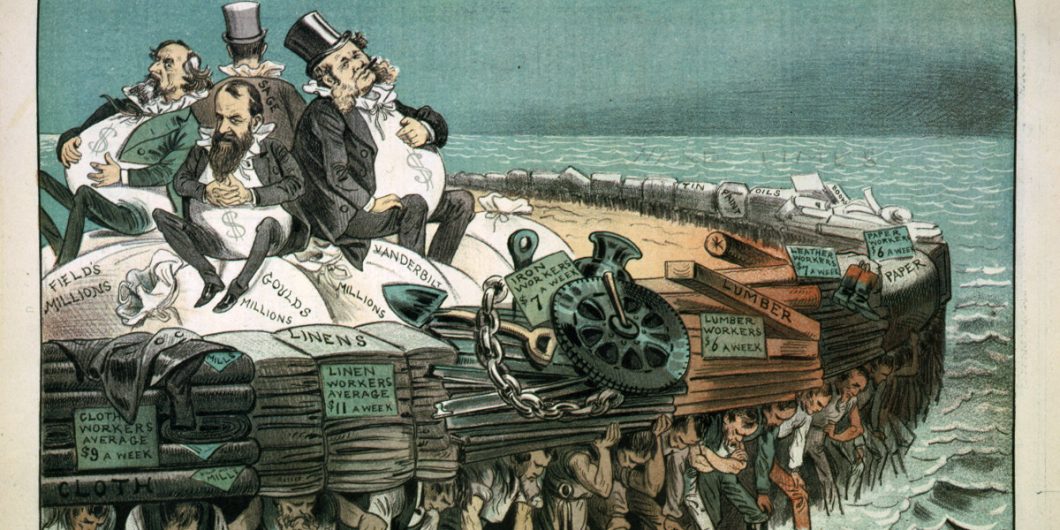Giving Democracy a Bad Name (Again)
For most of our history, Americans have regarded the original Constitution and what we now call “the administrative state” to be in conflict. In Philip Hamburger’s apt phrasing, “administrative law is unlawful.” The progressive-era engineers of the administrative state admitted as much—they knew that they had to find a way around the Constitution’s limitations on federal power. After their triumph in the New Deal, though, some of them began to construct an alternative history, in which the New Deal actually restored the powerful national state envisioned by the Founders (especially Alexander Hamilton), one which had been derailed—first by the antebellum “slave power,” then by the Gilded Age industrial plutocrats. (Paul Van Riper was among the first to articulate this argument, which he called “An Unorthodox View.”) More recently, a revised alternate history has arisen: the administrative state was not delayed or derailed at all. It had always been there, but we are only now recovering its “lost history.”
William Novak has been a major player in this revisionist project, expressed in an important 2008 American Historical Review article, “The Myth of the ‘Weak’ American State,” and his 1996 book, The People’s Welfare. A New Democracy, continues these 19th-centuries stories into the 20th century. It is, he says, part of his “long-term effort to debunk persistent and dangerous fallacies about an original American historical tradition defined primarily by transcendent precommitments to private individual rights, formalistic constitutional limitations, and laissez-faire political economy”—i.e., the classical liberalism of the Founding generation.
Why would Novak call adherence to the orthodox story on 19th century limited government “dangerous”? Because he believes that the myths of traditional constitutionalism pose an obstacle to the full acceptance of “our democracy.” The “new democracy” that provides the title for the book (taken from Walter Weyl’s 1912 book of the same title) is, not to put too fine a point on it, socialism. Novak never uses that term, preferring ones like “substantive democracy” or “social provision,” but it is nevertheless apparent that he is describing the modern welfare or “entitlement” state of equality of outcomes.
Novak (a law professor at the University of Michigan) takes his bearings from the “critical legal studies” school, an updated version of Marxism that sees law as the tool of the dominant powers in society—capitalists, whites, men, cisgender heterosexuals, et al. In his view, American government always actually facilitated dominance and repression even as it masqueraded as a liberal, rights-based regime. Oppression is “systemic,” built into the forms of law. This was given classic expression a century or so ago by people like Roscoe Pound in “Liberty of Contract” (1908) and especially by Robert Hale in “Coercion and Distribution in a Supposedly Non-Coercive State” (1923).
The 19th century story that Novak and others tell is almost entirely fanciful. There was plenty of activist government at the state level, exercising what was called “the police power,” but this was perfectly in keeping with the Constitution’s federal principles. (Novak is tone-deaf to federalism.) The national government was limited to its enumerated ends and objects, most of which had to do with foreign affairs and the borders—war and diplomacy, foreign trade, immigration, and the like. It did not begin to exercise its own police power until the 20th century, using the interstate commerce power as a pretext for it. Thus the “lost history” revisionists make mountains out of molehills when it comes to tax collection or the Steamboat Inspection Service. It is most notable that the Civil War necessitated all kinds of new federal powers, but those powers abated once the war was over (the Army demobilized, the income tax was repealed). The United States in 1900 was still the recognizably constitutional republic of 1800. Jerry Mashaw’s “Lost Century of Administrative Law” was just a century lost to administrative law.
Perhaps we ought to consider the Founders’ belief that the cure for the ills of democracy was representation, federalism, checks and balances—in a word, constitutionalism.
But Novak pulls back from his emphasis on the continuous growth of the American administrative state. Somewhere in the progressive era (1900-32) something fundamentally changed—a “change in kind,” he calls it. This change was the move toward the redistributive entitlement state. Proto-progressives (like Woodrow Wilson as early as the 1880s) recognized that the Framers’ Constitution was an obstacle to the need that they perceived to bring American government up-to-date with the social and economic changes of the industrial revolution. But until the New Deal their goals were relatively limited—regulating railroads, banks, policing the trusts. They were mostly meant to restore liberty and competition—such as had never really existed, Novak would say.
Before the New Deal there were almost no “transfer” programs that sought to redistribute resources and produce economic leveling. The New Deal brought about a wave of programs that were meant to benefit particular constituencies—the Agricultural Adjustment Act, the National Labor Relations Act, and Social Security (its laughable claim to be contributory “social insurance” notwithstanding).
But Novak cannot express this change overtly. “New Democracy” is a democracy that dare not speak its name. Weyl and his generation were much more willing to endorse socialism, though they repudiated Marxism for a Fabian, conditional, or pragmatic American version. As early as 1887 Woodrow Wilson noted “there was little or no principled difference between the two ideas” of democracy and socialism (though Wilson did not himself endorse socialism).
Novak’s book is written at a very high level of abstraction, a catalogue of intellectual sources of modern liberal statism, with rather tedious asides to engage Weber, Foucault, Habermas, and Eliade. It gives almost nothing of the political sources, policy-making, and especially policy impact of these ideas. The reader gets no sense, for example, of the political compromises that went into the Interstate Commerce Act, or why it was a dead letter for its first twenty years, or how it ruined the railroad industry when it was given real power in 1906. He fails to point out that the 1914 Clayton Antitrust Act and Federal Trade Commission Acts were empty gestures that changed nothing in American industrial structure. He has virtually nothing to say about the Federal Reserve Act and how the Board came to be so powerful, almost always by being rewarded with more power for its policy failures. A novice reader would scarcely know that labor unions, about which the progressives exhibited profound ambivalence, existed.
One of the most notable features of New Democracy is its marginalization of the Supreme Court and constitutional law. Early 20th-century progressives constantly bemoaned the Supreme Court as an obstacle to social and economic reform. The four decades before the New Deal constitutional revolution came to be called “the Lochner era,” after Lochner v. New York, a 1905 decision that held that a New York law limiting the number of hours that bakers worked violated Fourteenth Amendment “liberty of contract.” For over a generation now historians have recognized that cases like Lochner were few and far between, and that the Court was not the bête noir of progressive reform. Many libertarian scholars complain that the Court should have done more to impede statist legislation. But Novak gives us Lochner revisionism run amok, as if the Court were completely derelict in its duty and did nothing to uphold constitutional limits. In Novak’s construction, the Court’s recognition of constitutional limits on regulation served only to perpetuate classical “myths.”
Novak especially misses the “political” in the sense that these prophets of regulation wanted to rule, to remake American society in their own image, to establish a new regime. They were truly social engineers in the sense that Paul Johnson so ably outlined in Modern Times. The curse of the 20th century, Johnson observed, was the belief that experts, technocrats, bureaucrats, or planners “can shovel human beings around like concrete.” In this way, “our democracy” was fundamentally anti-democratic. “Substantive” democracy cannot abide the procedural (what the progressives dismissed as “formal”) democracy of political parties, representation, elections, and, above all, accountability of bureaucrat-engineer-experts to the people. Herbert Croly, a giant figure in the progressive movement, was honest enough to say in 1909, “the average American individual is morally and intellectually inadequate to a serious and consistent conception of his responsibilities as a democrat.” It is telling that Novak largely keeps Croly off-stage in New Democracy.
The kind of regime that the “New Democracy” of the administrative state sought to establish was already described a century and a half ago by Alexis de Tocqueville. He envisioned a new kind of “soft” despotism, “administrative despotism for lack of a better name.” The State would provide the vulgar, material pleasures that democratic men seek. A paternal state would “remove entirely from them the trouble to think and the difficulty of living.” It would regulate free men into a stupor, reducing them “to being nothing more than a flock of timid and industrious animals, of which the government is the shepherd.”
Tocqueville’s nightmare was reiterated in Dwight Waldo’s The Administrative State (1948), in a chapter entitled “The Good Life.” It expresses the Baconian-Hobbesian project of the scientific-technological conquest of nature to ease man’s estate and provide commodious living. The good society would be planned, he repeated, by a necessarily “big”—indeed “huge bureaucracy.” Its vision of the good life was frankly individualist and materialist: “The Good Life is chiefly a matter of the possession or enjoyment of tangible things.” Waldo conceded the procedural democracy (“means”) should be sacrificed for the sake of substantive democracy (“ends”). This echoed John Dewey, who wrote in Democracy and Educational Administration (1937) that “universal suffrage, recurring elections, responsibility of those who are in political power to the voters, and the other factors of democratic government are means that have been found expedient for realizing democracy as the truly human way of living. They are not a final end and final value.”
Ultimately, “new democracy” is not new at all. It is the old democracy that was condemned by the classical political philosophers and which still had a bad name at the time of the American Founding. In Aristotle’s formulation, “democracy” was the perverted form of government by the many, in which the many governed for the sake of the many rather than for the whole. Demagogues lead the 99% (or the 51%) to vote themselves the property of the 1% (or the 49%). The American Constitution was “anti-democratic” in this classical sense of the term. In the course of the 19th century, though, “democracy” came to lose its old, pejorative sense and became a shibboleth—largely because the Constitution and the American political system had made it workable. But modern progressives and liberals, who repeat the phrase “our democracy” ad nauseum, are really reactionaries who oppose constitutional democracy.
Novak repeatedly quotes progressives who averred that “the cure for the ills of democracy is more democracy.” Perhaps we ought to consider the Founders’ belief that the cure for the ills of democracy was representation, federalism, checks and balances—in a word, constitutionalism.


